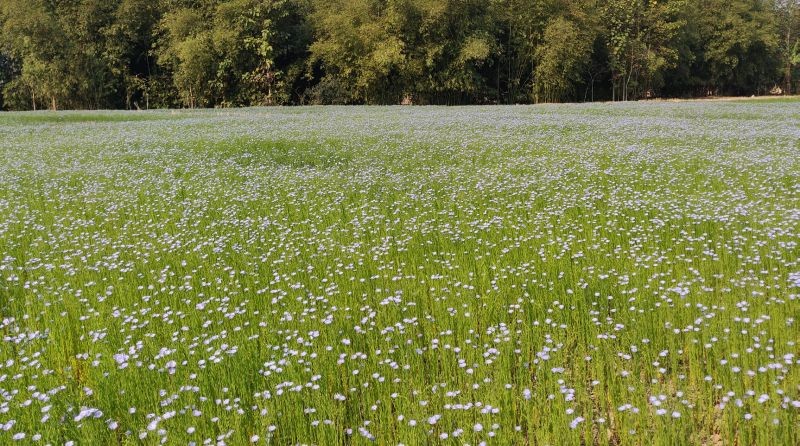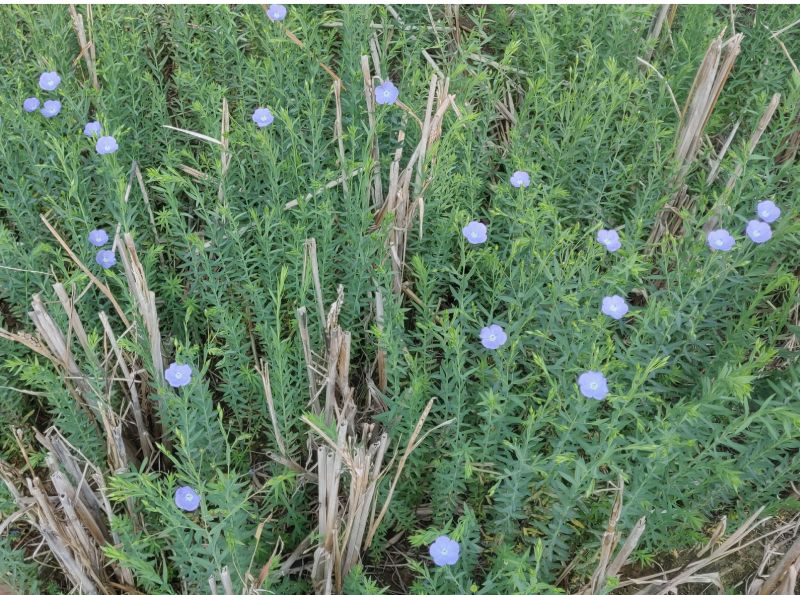
Dr Noyingthung Kikon, Prof L Tongpang Longkumer & Imlilemla Amlari
ICAR-AICRP on Linseed,
Medziphema Centre, NU: SASRD
Introduction
Linseed (Linum usitatissimum), known as ‘Tisi’ in Hindi and ‘Flax’ in western countries, is an important dual purpose rabi oilseed crop recently introduced in Nagaland. It is an important industrial and edible oil and fiber-producing crop. Linseed contains 33 to 47% oil and due to quick drying and water resistant properties of linseed oil it is used in a number of industrial applications viz., paints, varnishes, linoleum flooring, printing inks, oil clothes, patent leather, waterproof fabrics, soaps, etc. The oil cake also contains 36% crude protein and is an excellent protein source for livestock as well as an excellent organic manure. Flax fibers, extracted from the bast beneath the surface of the stem, is 2 to 3 times stronger than cotton and is naturally soft, smooth, straight and lustrous. Flax fibers are woven into a fabric generally known as ‘linen’ and also used in manufacturing of twine, rope, webbing, canvas, laboratory papers, cigarette rolling paper and tea bags. In Nagaland, given the large tracts of cultivable lands which are left fallow after rice during rabi season, there is huge potential and scope for adoption of linseed as an economical crop (either as a pure ‘rabi’ crop or as a utera crop) in rice based sequential cropping systems will not only ensure regular and additional returns to the farmers but also diversify their production system as well as increase the productivity and production of our cultivable lands. Moreover, the crop being suitable for marginal and poor exhausted soils can be easily adopted in rice fallows with minimum inputs and management practices.
Paira/utera Crop

Relay cropping of linseed in standing paddy crop is known as Paira/Utera system, which covers 25% of linseed area in India. In this system land preparation is excluded and the crop is grown on residual nutrients and moisture wherein, the seeds are broadcasted in standing paddy crop 10 to 15 days before harvesting of paddy (flowering to dough stage of rice). Crop yields under this system are lower compared to rainfed pure crop however; due to lower cultivation costs the benefit cost ratio of this system is almost comparable to that of pure ‘rabi’ crop. In context of Nagaland, with reference to rice/paddy farmers, one of the major problems attributing to late sowing or exclusion of rabi crop is due to the longer turn-around time (for land preparation) after harvesting of rice. Paira/utera system of linseed cultivation can be effortlessly adopted in rice based cropping systems to address and mitigate these issues.
Nutritional and health benefits
For centuries linseed have been prized for its health–protective properties. In fact nowadays, it is emerging as a ‘superfood’ as more scientific research points to its health benefits. Linseed is one of the best plant sources of Omega-3 fatty acids (ALA), which plays an important role in lowering cholesterol, reducing inflammatory disorder like rheumatoids arthritis and providing immunity and cardiovascular benefits. Soluble and insoluble dietary fibers found in linseed also helps in regulating cholesterol, blood sugar levels and promotes digestive health. A number of studies have shown that adding flax to one’s diet has resulted in reduced body mass index and a smaller waist circumference. Linseed is also one of the richest dietry sources of lignin (100 times more lignan than foods), which provides protection against certain forms of cancer due to estrogenic and anti-estrogenic activity in the body.
Plant description

Linseed is a self-pollinated annual plant that grows to a height of 1 to 4 feet with glacous green, lanceolate, alternate and sessile leaves and slender stem, which may branch from the base. It has shallow taproot with numerous lateral roots. Depending on variety, flowers are blue or white which opens in the morning hours. Fruit is a dry capsule/seed ball with flat and glossy (apple pip shaped) white/yellow/light brown seeds.
Recommended package of practices
Climate
The crop requires moderate or cool temperature during vegetative stage and dry weather during maturity of the crop. Optimum temperature ranges are:
Germination and seedling stage: 25-35o C
Flowering: 21-26°C during flowering
Seed formation: 15-20o C during seed formation.
Annual rainfall: 450-750 mm
Optimum elevation range: 400 to 500 m
Soil
Well-drained, moderately deep silt loam, clay loam & silty clays. Light soils are not suitable especially in low rainfall areas. The best soil type is well-drained clay loam with high organic matter content and an ideal pH range of 5.5 to 7.0.
Land preparation
2-3 ploughings with cultivator fb. 2-3 harrowing to obtain debri and weed free seedbed free. Hoeing after each shower conserves the soil moisture.
Varieties
Shekhar, T- 397, BAUP 101 (utera), RLC-143 (utera), Surabhi, Sweta, Shubra, Garima, Parvati, Ruchi.
Sowing time
Pure rabi crop (rainfed crop): Complete sowing by 15th Nov.
Irrigated crop: Complete sowing by 25th Nov.
Utera crop: Broadcast seeds 15 days before harvest of paddy (soil should be moist)
Early sowing helps to escape attack of powdery mildew, rust, and linseed bud fly.
Seed Rate, spacing, sowing depth and plant population
The following seed rates are optimum under moist conditions:
Line sowing: 20 to 30 kg/ha (25 to 30 cm row to row spacing)
Broadcasting (Utera): 35 to 40 kg/ha
Depending on soil moisture conditions shallow sowing at 2-3 cm depth (moist soil) or deep sowing at 5-8 cm depth (dry soil) should be done to ensure proper germination and crop establishment. Preferably, sown the seeds at shallow depth on the same or next day of ploughing. Thinning should be done 15 days after crop emergence maintaining plant to plant distance of 10 cm to obtain an optimum plant population of 4 to 5 lakh plants/ha.
Seed treatment
Seed treatment with thiram or bavistin @ 2.5g/kg of seed to protect against seed and soil borne diseases
Nutrient Management
Peak period of nutrient requirement: Bud formation to peak flowering
Recommended/optimum doses of NPK:
Rainfed crop: 40:20:20 kg NPK/ha
Irrigated crop: 90:40:30 kg NPK/ha
Utera crop: 10 to 20 kgs N/ha
Time and method of application of fertilizers
Deep placement of fertilizers 5 cm below and away from the seed in moist zone
Rainfed crop: Full dose of NPK as basal dose during sowing
Irrigated crop: ½ dose of N + full dose of P & K as basal dose at the time of sowing fb. remaining ½ dose of N at first irrigation (35 days after sowing).
Utera crop: Broadcast full dose of N when the seedlings are 10 cm tall
Following nutrient management practices can also be adopted for optimum growth and yield:
Apply FYM or compost @ 5-8 t/ha during final land preparation
Green manuring with dhaincha (Sesbania aculeata) in preceeding crop @ 35 kg/ha
Broadcast and mix 30-40 kgs/ha of gypsum in the top 10-15 cm of soil to improve the oil yield
Weed Management
The crop should be kept weed free for the first 35 to 60 days after sowing. Two hand weedings at 4 and 7 weeks after sowing are sufficient to keep the weed population below threshold level.
Following chemical control measures are recommended:
Rainfed and irrigated crop: Post emergence Isoproturon@ 1.0 kg/ha ‘or’ pre emergence pendimethalin @1.0 kg/ha fb.post emergence metsulfuron methyl @ 4g/ha
Utera crop: Post emergence Isoproturon@ 1.0 kg/ha
Irrigation
Frequent light irrigations are ideal and economical than heavy irrigations at longer intervals. Irrigations at critical stages like flowering and seed development is essential under moisture stress conditions.
A minimum of two irrigations is required:
First irrigation: 35 days after sowing
Second irrigation: 65 days after sowing
If irrigation water is available, 3 irrigations (at 35, 55 & 75 DAS) can be given.
Harvesting
Depending on duration of the variety, for seed purpose the crop should be harvested when the plants turn golden yellow, leaves start drying and falling off and capsules starts browning and cracking. The thumb rule is to harvest when 90% of the seed capsules turn brown and seeds turn shiny. For fibre purpose, harvesting should be done at physiological maturity a month after flowering or 2 weeks after capsule formation when the base of the plant starts turning yellow. Crop is harvested from March to April depending of variety and climatic conditions. Cut the plants close to the ground and sun-dry in the field for few days. After proper drying, threshing is done by trampling with bullock. The seed is separated from chaff by winnowing and stored in dry place.
Yield
With recommended packages of practices and depending on variety used, one can realize a yield of 10 to 15 q/ha of seeds with pure rabi crop under rainfed conditions and 5 to 9 q/ha of seeds under utera conditions. Oil content of seeds ranges from 33-36 % depending on variety.




